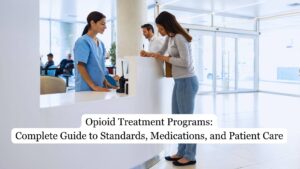What Are Prescription Opioids and How Do They Relieve Pain
Prescription opioids are powerful pain medications derived from the opium poppy plant, designed to relieve pain by acting directly on the nervous system. They attach to opioid receptors in the brain, blocking pain signals and changing the brain’s perception of discomfort. These opioid pain treatments are commonly used to treat moderate to severe pain caused by injury, surgery, or chronic pain conditions.
Medications such as codeine, fentanyl, morphine, oxycodone, and hydrocodone are among the most common opioid drugs prescribed by doctors. While effective, they must be used with caution, as opioids can also create feelings of euphoria, increasing the risk of drug abuse and opioid addiction.
What To Do If You Are Struggling With Opioid Addiction
If you or someone you love is battling opioid addiction, Raise The Bottom offers compassionate, evidence-based care to help you find lasting recovery. Our addiction treatment center provides personalized support and medical guidance every step of the way. Explore our comprehensive guide for Opioid Treatment Programs to learn about safe, effective paths toward healing.
How Pain Medications Work in the Body
Pain medicines work by targeting the nerve cells in the body that transmit discomfort. When opioids work, they block signals, helping patients feel better and improve quality of life. For those with acute pain or mild to moderate pain, healthcare providers may recommend anti inflammatory drugs such as ibuprofen or naproxen sodium before turning to opioid drugs.
These pain relievers and some others are part of a balanced approach to treating pain effectively. However, in some cases of long term pain, stronger prescription opioids are required for adequate relief.
Learn how long opioids stay in your system here.
Commonly Prescribed Pain Medications

Doctors use different pain medications depending on a patient’s condition, the source of pain, and its severity. These drug classes include both over the counter and prescription options that target the body’s pain pathways to provide effective relief while minimizing side effects.
Nonsteroidal Anti Inflammatory Drugs (NSAIDs)
NSAIDs are widely available with or without prescriptions and are often the first choice for managing mild discomfort or inflammation. They work by reducing pain and inflammation in muscles, joints, and connective tissue.
Common NSAIDs include:
- Ibuprofen
- Naproxen Sodium
- Aspirin
- Ketoprofen
Acetaminophen (Paracetamol)
Acetaminophen is one of the most used pain medicines for headaches, menstrual cramps, or mild to moderate pain. It helps relieve pain and lower fever but does not reduce inflammation.
Common brand names include:
- Tylenol
- Panadol
- Mapap
- Ofirmev (IV form used in hospitals)
Prescription Opioids
Prescription opioids are used to treat moderate to severe pain that does not respond to other medications. These opioid pain treatments target the brain’s opioid receptors to block pain signals and relieve pain effectively, though they must be monitored for risk of opioid addiction.
Common prescription opioids include:
- Oxycodone (OxyContin, Percocet)
- Hydrocodone (Vicodin, Norco)
- Morphine (MS Contin, Kadian)
- Codeine Fentanyl (Duragesic, Actiq)
- Methadone
The Connection Between Prescription Opioids and Drug Abuse
The national institute on drug use reports that drug abuse involving prescription opioids has become a major public health concern. Many individuals begin using opioid pain relievers for legitimate pain relief, only to develop dependence over time. Because these drugs are called narcotics and can alter mood, they are often misused for their euphoric effects.
This misuse can lead to substance use disorder, a condition that includes opioid addiction and, in some cases, dependence on other drugs or other medications. Those who take higher doses or frequent doses are at greater risk of experiencing withdrawal symptoms when they stop using the medication.
Opioid Overdose and the Risks of Misuse
Taking large doses of opiates, especially in combination with other drugs or alcohol, can cause life-threatening overdose. Symptoms include slowed breathing, impaired judgment, confusion, and loss of consciousness.
According to the cdc clinical practice guideline, opioid overdose deaths have risen sharply over the past two decades, particularly among those with untreated opioid use disorder. Combining opioids with other medicines that depress the nervous system further increases the danger.
Safe prescribing practices and close monitoring from a healthcare provider are essential to prevent these tragedies.
Managing Pain Safely: Alternatives and Prevention
To manage pain responsibly, physicians often start with nonsteroidal anti inflammatory drugs or over the counter pain meds for mild pain. These alternatives are generally safe when used correctly and help relieve pain caused by inflammation or minor injury.
For long term pain, doctors may combine opioid drugs with other medicines or therapies such as physical rehabilitation. This practical management approach helps patients function better while reducing their reliance on narcotics.
Additionally, ongoing education about prescribing opioids and awareness of opioid use disorder are key to curbing drug abuse and preventing opioid overdose.
The Role of Healthcare Teams in Opioid Treatment

A patient’s healthcare team plays a central role in the safe use of prescription opioids. Providers are responsible for monitoring dosage, watching for signs of opioid misuse, and offering support to those developing dependence.
When addiction occurs, treatments may include medications like buprenorphine or methadone, which help manage withdrawal symptoms and reduce cravings. These medications, along with counseling, can help individuals overcome opioid addiction and regain stability.
For individuals living with chronic pain, doctors work closely with patients to balance the benefits of pain relief with the risks of opioid drugs. Proper communication between the patient and healthcare team ensures safety and better health outcomes.
Balancing Pain Relief and Safety
Finding the right pain killer medicine prescribed requires careful consideration of the condition being treated, the potential for side effects, and the risk of addiction. While opioid pain relievers are effective for short-term or severe pain, NSAIDs and over the counter alternatives can often provide adequate relief with fewer risks.
Patients should always consult their healthcare team before combining other medicines or taking higher doses. Safe usage, education, and support systems are the foundation of effective practical management for chronic pain and prevention of opioid overdose.
Over the Counter Drugs and Other Medicines For Chronic Pain
A systematic review of treatment options for chronic pain shows that combining over the counter medications with other medicines can help relieve moderate discomfort for various types of pain, including nerve pain.
What To Do With Long Term Pain
While these treatments are safer than opioids, some people require more frequent doses to maintain relief, increasing the risk of physical dependence. Using them responsibly, under guidance from a healthcare provider, ensures effective and lasting pain management without unnecessary complications or misuse.
Final Thoughts on Opioid Pain Killer Medications
Opioids remain essential pain medications for people dealing with long term pain and chronic pain, but their potential for harm cannot be ignored. By understanding how these pain relievers work, using them only as prescribed, and exploring safer alternatives like nonsteroidal anti inflammatory drugs, patients can achieve sustainable pain relief without the risks of opioid misuse or addiction.
Public awareness, strong healthcare team oversight, and continued education from the national institute for health professionals will ensure that opioid pain management remains both compassionate and safe.






